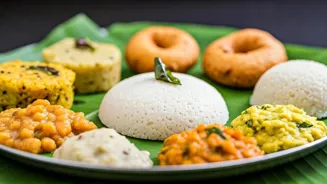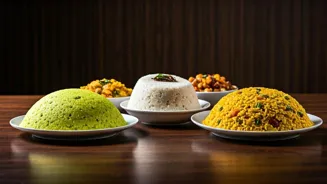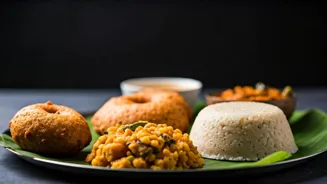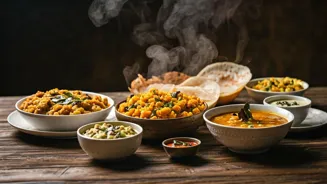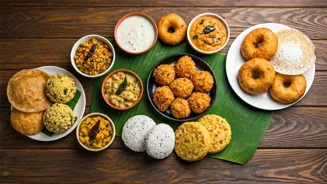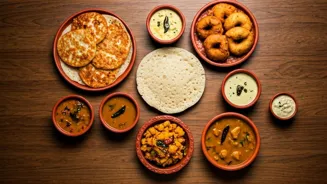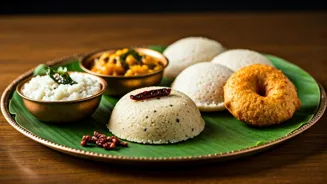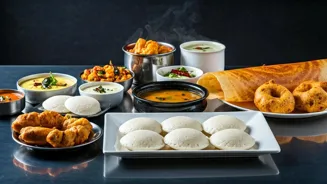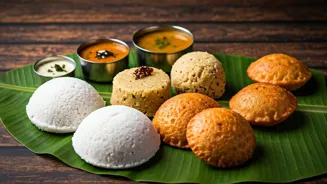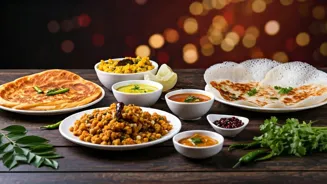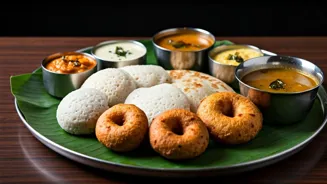Appam with Stew
Appam, a pancake-like dish with a soft, spongy center and crispy edges, is a popular breakfast choice, often paired with a flavorful vegetable or meat
stew. The batter is made from fermented rice and coconut milk, giving it a slightly tangy taste. The stew typically includes vegetables like potatoes, carrots, and beans, simmered in a coconut milk-based gravy with spices like cardamom and cloves. This combination presents a comforting start to the day, with the appam providing a textural contrast to the stew's richness. The preparation method is relatively straightforward; it involves fermenting the batter overnight and then cooking the appams in a special pan that gives them their unique shape. The stew's spices provide warmth and a blend of flavors that complement the mild appam, making this a satisfying and balanced breakfast option.
Puttu and Kadala Curry
Puttu, a steamed cylinder of ground rice and coconut, is a staple, particularly in Kerala, usually served with Kadala curry, a black chickpea curry. The rice flour is layered with grated coconut in a cylindrical mold and then steamed. This process gives puttu a fluffy, slightly sweet flavor, complemented by the savory curry. Kadala curry, made from black chickpeas, onions, tomatoes, and a blend of spices such as coriander, cumin, and red chili powder, provides a rich, aromatic sauce that enhances the puttu. The combination of soft puttu and the hearty curry makes for a fulfilling breakfast. Puttu’s simplicity and Kadala Curry’s complex flavors showcase the balance of regional cuisine. The ingredients and techniques are accessible, which makes this breakfast easily replicable.
Upma variations
Upma, a semolina-based dish, features diverse regional variations. While the basic version involves semolina, vegetables, and spices, many regional adaptations add unique elements. For example, some versions might include the addition of vegetables like peas, carrots, and beans, adding more texture and nutrition. Another example may incorporate roasted peanuts or cashews, offering a nutty flavor and added crunch. In certain regions, the dish is seasoned with mustard seeds, curry leaves, and asafoetida, adding a distinctive aroma and taste. Preparation methods vary from simple sauteing to more elaborate cooking techniques, depending on the desired flavor profile. Each version provides a distinctive culinary experience, showcasing the adaptability of Upma to diverse regional palates. These variations use locally available ingredients and cooking styles, reflecting local preferences.
Pongal & Sambar
Pongal, a rice and lentil porridge, is a traditional breakfast, usually served with sambar, a lentil-based vegetable stew. The rice and lentils are cooked together with spices like cumin, pepper, and ginger, and then tempered with ghee, nuts, and curry leaves. This results in a creamy, flavorful dish with a comforting texture. Sambar is made from lentils, vegetables, and tamarind, creating a tangy and savory accompaniment. The combination of the sweet pongal and the tangy sambar is a culinary delight, often enjoyed with chutney. The ingredients in Pongal and Sambar are easily accessible, making them a staple. Pongal's cultural significance is deep-rooted. The cooking process and ingredients provide nutritional balance.
Idiyappam & Egg Curry
Idiyappam, or string hoppers, is a breakfast food consisting of steamed rice noodles, typically served with egg curry. The noodles are made from rice flour, which is pressed into thin strands and steamed. This gives them a delicate texture and a mild flavor. Egg curry provides the protein and spice to this dish. The curry is made from eggs cooked in a gravy of onions, tomatoes, and a blend of spices. The mildness of the idiyappam complements the spiciness of the curry. Idiyappam's preparation requires specialized equipment, but the ingredients are readily available. Egg curry offers a hearty counterpoint to the subtle taste of the idiyappam, making it a flavorful breakfast.
Masala Dosa Variations
Beyond the basic dosa, there are numerous variations, with masala dosa being a popular choice. Masala dosa includes a potato filling seasoned with spices. The dosa itself is a thin crepe made from fermented rice and lentil batter, providing a crispy texture. The filling generally contains boiled potatoes, onions, mustard seeds, and curry leaves. Regional variations may include different spices or cooking methods. Mysore masala dosa is another variation which includes a layer of red chutney on the dosa before adding the potato filling. Other variations involve using different types of fillings, such as paneer or vegetables. The dosa batter's fermentation process contributes to the distinctive taste, while the fillings offer flavor variations. Masala dosas are versatile, with customizations catering to regional taste preferences. This allows for personalization depending on taste.
Rava Dosa with Chutney
Rava dosa, made from semolina, rice flour, and spices, offers a quick alternative to traditional dosa. Unlike regular dosa, the batter doesn't need fermentation, which makes it a faster breakfast option. The batter is thin and is poured onto a hot griddle. This makes a crispy and lacy texture. This dosa is served with a variety of chutneys. Coconut chutney and tomato chutney are common choices, each providing contrasting flavors to the dosa. Rava dosa is a less time-consuming alternative to other South Indian breakfasts. The method is accessible for home cooks, offering a convenient way to enjoy South Indian flavors. Chutneys supply complementary flavors. The rava dosa’s texture makes it stand out.
Uttapam Variety
Uttapam, a thick pancake made from fermented rice and lentil batter, is another option. It is often garnished with vegetables and served with chutney and sambar. The batter is similar to dosa batter, however the consistency is thicker. The uttapam can be topped with various ingredients, such as onions, tomatoes, capsicum, and green chilies. This adds to the flavors and textures. Different chutneys, such as coconut chutney and tomato chutney, offer flavor contrasts. Uttapam provides a hearty and customizable breakfast with several nutritional benefits. Its adaptability makes it suitable for various preferences, including the easy addition of vegetables. The fermentation is part of the making process and contributes to the flavor.
Bonda & Sambar
Bonda, a deep-fried snack made from lentil batter, is often paired with sambar, a lentil-based vegetable stew. Bonda is made from a batter of ground lentils, mixed with spices and sometimes vegetables, and then deep-fried until golden brown. It provides a crispy exterior and a soft interior. Sambar adds a savory flavor and moisture to the meal. The combination offers contrasting textures and tastes. Bonda is a fulfilling option, providing a satisfying crunch and flavor. The use of locally available ingredients adds to its appeal. The pairing of Bonda and Sambar provides a complete meal, which makes it a popular breakfast.
Pesarattu & Chutney
Pesarattu, a crepe-like dish made from green gram, is often served with chutney. The batter is made from soaked green gram, which is ground into a fine paste and then spread onto a hot griddle to create a thin crepe. The addition of onions and chilies gives added flavors. The dish offers a lighter alternative to other breakfast options, with green gram providing protein and fiber. Chutney, generally coconut chutney or ginger chutney, provides flavor and moisture, balancing the dry texture of the pesarattu. This breakfast offers a combination of health benefits and flavor. The use of simple ingredients and the ease of preparation make it suitable for everyday cooking. This is a fulfilling and nutritious breakfast.
